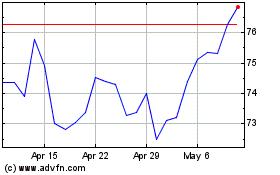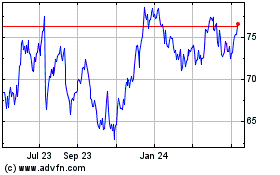The Data Divide: Institutional Investors Split Between Leaders and Laggards on Turning Big Data to Smart Data
November 12 2013 - 9:00AM
Business Wire
State Street Study Outlines the Five Steps Firms Can Take to
Turn Volume into Value
State Street Global Exchange released today the following
insights about the future of data and the institutional investment
industry, which can also be found in a new report1, “Leader or
Laggard: How Data Drives Competitive Advantage in the Investment
Community.” The study, conducted in collaboration with the
Economist Intelligence Unit (EIU), surveyed more than 400
institutional investors globally and revealed an industry that is
divided between “data leaders” and “data laggards.” The former are
companies that harness data and analytics for competitive advantage
and the latter still struggle to manage and exploit the full
potential of their data.
The most pressing challenges that emerged as key concerns for
the industry center on the volume, velocity and variety of data.
Respondents noted challenges including the accuracy of data (37
percent), followed closely by the lack of integration between
different data sources and types, and timeliness of data. Although
two-thirds of executives agree that leading-edge data and analytics
capabilities will be among their most important competitive
advantages in the future, only 29 percent strongly agree that their
firms are already gaining a competitive advantage from their data
today. 22 percent have a high degree of confidence in their ability
to optimize electronic trading strategies and 22 percent think
their benchmark data is a significant strength.
“The pace and volume of change in the financial markets are
pushing institutional investors to become more nimble and wield
data strategically,” said Jeff Conway, executive vice president and
head of State Street Global Exchange. “Data without the ability to
deploy it to solve a problem is just noise. As investment
opportunities are increasingly harder to identify and more complex
to execute, firms who can prioritize their approach to data
management will emerge as leaders.”
Data leaders are better equipped to manage these challenges and
convert big data to smart data. They excel at extracting insight,
managing risk and performance and trading electronically.
According to the State Street Study:
- Seventy percent of data leaders are
confident they can generate forward-looking insights from their
data, compared to 43 percent of laggards;
- Seventy-two percent are confident about
integrating performance and risk analytics, compared to only half
of laggards;
- Sixty-eight percent are very confident
about being able to conduct scenario and stress testing investment
portfolios, versus only 38 percent of data laggards;
- Ninety-two percent of leaders believe
their investments in data and analytics are keeping pace with the
growth of their business, compared to only half of laggards;
- Leaders are investing in smarter,
faster investment decisions. Over the next three years, 89 percent
plan to raise their investment in order management and execution
management systems, 77 percent plan to invest more in portfolio
modeling and optimization systems, 70 percent say they plan to
invest further in benchmark data and 64 percent expect to increase
their investment in risk analytics.
What are the five steps necessary to becoming a data
leader?
1) Improving risk tools with multi-asset class capabilities
2) Developing better tools to manage regulation in multiple
jurisdictions
3) Improving the ability to manage and extract insight from
multiple data sources
4) Optimizing electronic trading platforms
5) Developing a scalable data architecture that will grow with
your business
“The capabilities and strategies that firms put in place today
will lead to data systems that need to serve the business for many
years to come and getting these decisions right is critical,”
continued Conway. “Becoming a data leader isn’t easy and there is
no room for complacency. Harnessing the value of big data isn’t
just about investing in technology, it’s about having the right
teams and partners in place to turn volume into value.”
State Street Global Exchange combines capabilities in research
and advisory, portfolio performance and risk analytics, electronic
trading and clearing, information and data management, along with
new innovations to help asset owners and managers gain new insights
and execute investment decisions efficiently.
For further information on the study and to view the executive
summary, please click here. For special materials and other
information, follow State Street on Twitter @State Street.
About State Street Corporation
State Street Corporation (NYSE: STT) is one of the world's
leading providers of financial services to institutional investors
including investment servicing, investment management and
investment research and trading. With $26 trillion in assets under
custody and administration and $2.2 trillion in assets under
management* at September 30, 2013, State Street operates in more
than 100 geographic markets worldwide, including the U.S., Canada,
Europe, the Middle East and Asia. For more information, visit State
Street’s web site at www.statestreet.com.
*This AUM includes the assets of the SPDR Gold Trust (approx.
$39 billion as of September 30, 2013), for which State Street
Global Markets, LLC, an affiliate of State Street Global Advisors,
serves as the marketing agent.
1State Street commissioned the Economist Intelligence Unit to
conduct a survey of more than 400 financial services executives
representing a cross-section of the investment industry, with a
roughly equal balance between asset owners and asset managers.
Respondents were globally distributed, with roughly one-third based
in North America, one-third in Asia Pacific and one-third in
Europe. To round out our report, the survey results were supported
by in-depth interviews with industry executives conducted by
Longitude Research.
CORP-0899
State Street CorporationAnne McNally, +1 617 664
8576aemcnally@statestreet.com@StateStreet
State Street (NYSE:STT)
Historical Stock Chart
From Jun 2024 to Jul 2024

State Street (NYSE:STT)
Historical Stock Chart
From Jul 2023 to Jul 2024
